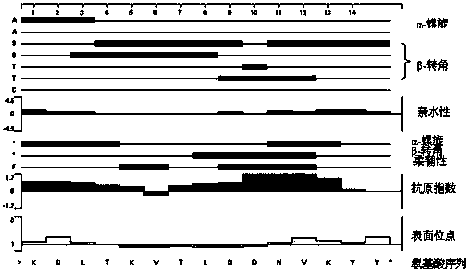Transient receptor potential channel-6 (TRPC6) antigen polypeptide and anti-TRPC6 monoclonal antibody
A monoclonal antibody and antigen polypeptide technology, applied in the field of cell engineering, can solve the problem of no immunogen antigen polypeptide, etc., and achieve the effect of strong specificity, single biological activity and high uniformity
- Summary
- Abstract
- Description
- Claims
- Application Information
AI Technical Summary
Problems solved by technology
Method used
Image
Examples
Embodiment 1
[0028] Example 1 TRPC6 antigen polypeptide design
[0029] (1) Sequence screening of TRPC6 synthetic peptides
[0030] Taking the TRPC6 protein as the research object, look for a sequence on the TRPC6 molecule, which should not be too long, about 15 amino acids, must be in a conserved region, and will not change between different species; and determine whether it is an intracellular or extracellular segment (TRPC6 molecule Complicated, with 6 transmembrane structures); compare the homology between species (protein blast in NCBI); at the same time, it is necessary to consider whether other proteins also have this sequence, and it is best for the antibody used for identification and diagnosis to have this sequence in the same Other molecules in the family do not have specificity, otherwise they are prone to cross-reaction and cannot be used as in vitro diagnostic reagents.
[0031] (2) Analysis of TRPC6 synthetic peptide epitope and hydrophilicity
[0032] The selected seque...
Embodiment 2
[0034] Example 2 Preparation of monoclonal antibody against TRPC6
[0035] (1) Antigenic peptide synthesis and animal immunization
[0036] According to the antigenic polypeptide designed in Example 1, the polypeptide is coupled with KHL, and the healthy BALB / c mice are immunized, and the age of the mice is 6-12 weeks, male or female. In order to avoid poor reaction of mice or death during immunization, 3-4 mice can be immunized at the same time. Multi-point immunization was used. After the second and third immunizations, the titer of mouse serum was determined by indirect ELISA method, and the one with the highest immune titer was selected for booster immunization to prepare for cell fusion.
[0037](2) Preparation of myeloma cells and feeder cells
[0038] The mouse myeloma P3X63Ag8.653 cell line (purchased from the Cell Resource Center, Shanghai Institutes for Biological Sciences, Chinese Academy of Sciences) was selected to be cultured in RPMI-1640 medium with 10% feta...
Embodiment 3
[0051] Example 3 Application of Monoclonal Antibody Detection in TRPC6 Molecular Overexpression Tissues
[0052] (1) Application of monoclonal antibody in immunolabeling technology
[0053] The monoclonal antibody was labeled with horseradish peroxidase to construct a double-antibody sandwich method. The labeling method is sodium periodate method, marked
PUM
 Login to View More
Login to View More Abstract
Description
Claims
Application Information
 Login to View More
Login to View More - R&D
- Intellectual Property
- Life Sciences
- Materials
- Tech Scout
- Unparalleled Data Quality
- Higher Quality Content
- 60% Fewer Hallucinations
Browse by: Latest US Patents, China's latest patents, Technical Efficacy Thesaurus, Application Domain, Technology Topic, Popular Technical Reports.
© 2025 PatSnap. All rights reserved.Legal|Privacy policy|Modern Slavery Act Transparency Statement|Sitemap|About US| Contact US: help@patsnap.com



